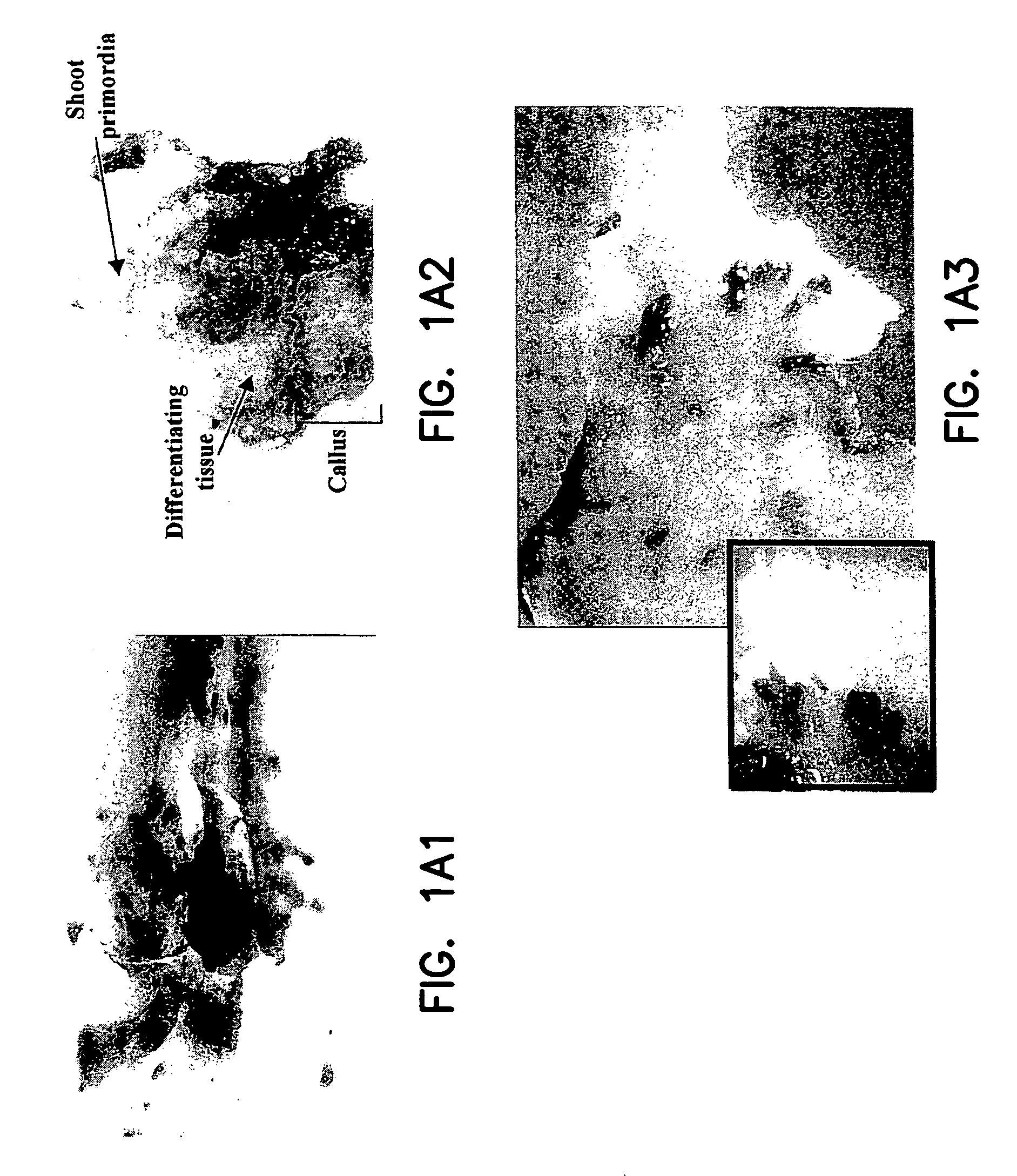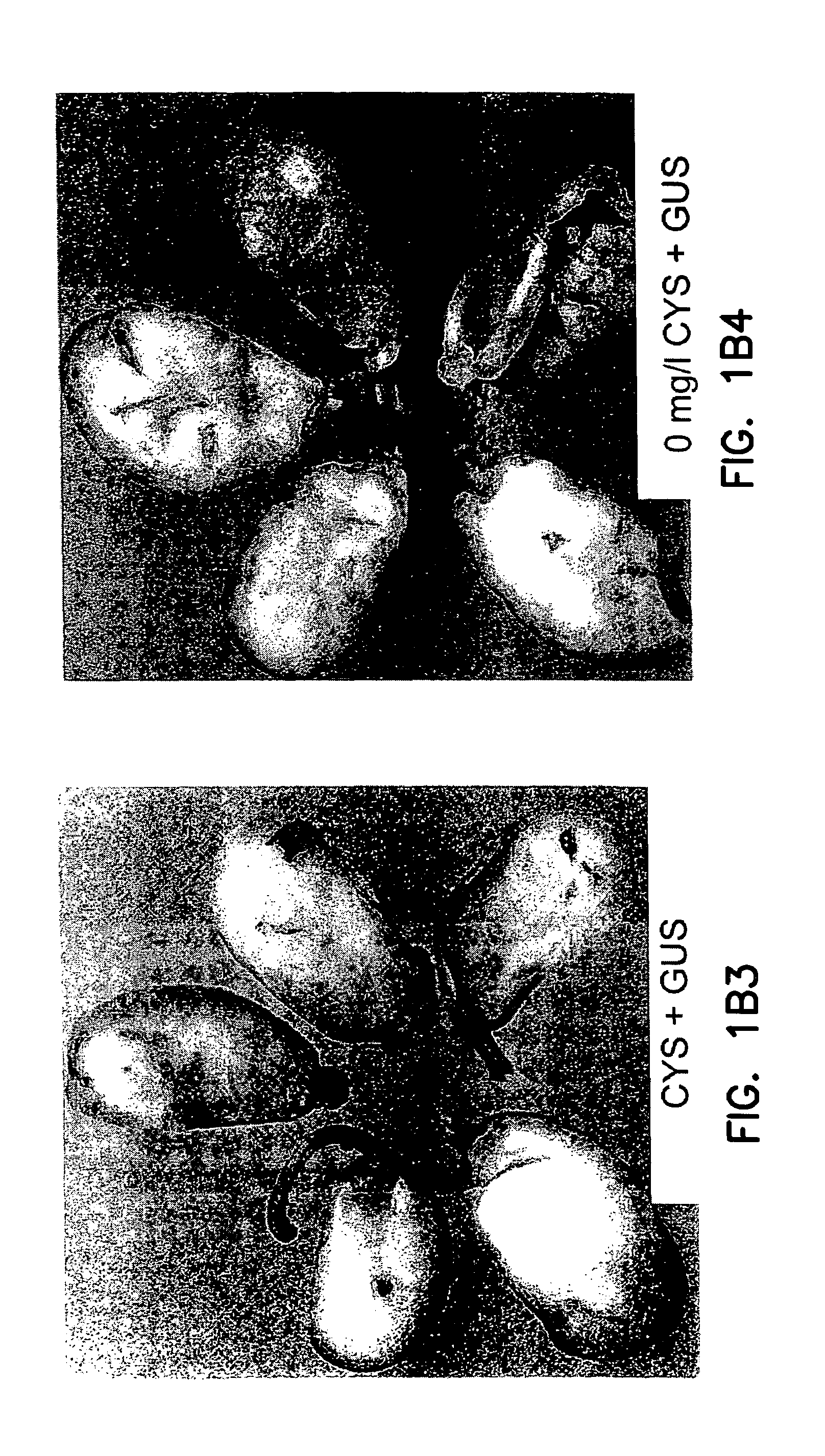Method to enhance Agrobacterium-mediated transformation of plants
a technology of agrobacterium and plant, applied in the field of enhancing agrobacterium-mediated transformation of plants, can solve the problems of many molecular, genetic and genomic techniques commonly used in other major crops, such as maize, and the efficiency of the cot-node transformation system remains low, and achieves the effects of increasing the number of gus+ shoots, increasing the frequency, and increasing selection pressur
- Summary
- Abstract
- Description
- Claims
- Application Information
AI Technical Summary
Benefits of technology
Problems solved by technology
Method used
Image
Examples
example i
Agrobacterium Strains
[0153]One of two different Agrobacterium strains containing different binary plasmids were used to transform soybean explants using the cotyledonary-node (cot-node) method (see U.S. Pat. Nos. 5,942,660 and 5,959,179). A number of the experiments use Agrobacterium strain AGL1 and a binary plasmid BSF16 that contains the bar gene for selection using the herbicide Liberty® (AgroEvo™; bar encodes for phosphinothricin acetyltransferase that detoxifies phosphinothricin, “PPT”, or glufosinate), the phenotypic marker uidA (gusA) gene which encodes for β-glucuronidase (GUS), and a sulfur-rich gene albumin from sunflower (Molvig et al., 1997) driven by the seed-specific promoter from the pea vicilin. The constitutive promoter, CaMV 35S, drives both the gusA and the bar gene in pBSF16. The second Agrobacterium strain, LBA4404, contains the binary plasmid pTOK233. pTOK233 contains the gusA gene under the control of the CaMV 35S promoter and the hpt gene under the control of...
example ii
[0190]The following results include results from experiments described in Example I as well as results from additional experiments. Wounded soybean cot-node explants prepared from the cultivar ‘Bert’ were co-cultivated with Agrobacterium on solid co-cultivation medium containing various levels of cysteine for 5 days. Agrobacterium strain AGL1 was employed which contains the binary plasmid, pBSF16, which carries in its T-DNA the bar gene as a selectable marker and the E. coli gusA (GUS) gene under control of the CaMV 35S promoter; gusA expression occurs in plant cells but not in bacteria due to an altered 5′ leader sequence (Molvig et al., 1997). Following co-cultivation, T-DNA transfer to cells in the soybean cot-node was determined by scoring GUS transient expression (GUS+ ) using GUS histochemical staining (FIG. 1A1). For these experiments, GUS staining was scored in the cot-node region, defined as the node tissue between the junction of the epicotyl and hypocotyl, and the cotyled...
example iii
[0200]The positive affect cysteine has on Agrobacterium-mediated T-DNA transfer occurs during the 5-day incubation on solid co-cultivation media. There are no increases detected when cysteine is amended solely to either the liquid YEP or liquid co-cultivation medium. This suggests that the plant explant is interacting with cysteine either alone or with Agrobacterium. To determine whether the response to cysteine is due to a nutritional gain (cysteine acting as an amino acid) in the medium or another factor, D-cysteine was amended to the solid co-cultivation media. The results of this experiment showed that both L- and D-cysteine increase GUS+ foci at both the 5-day and 28-day interval in an analogous manner. Cysteine, therefore, is not increasing T-DNA transfer through medium enrichment.
[0201]Cysteine is known decrease enzymatic browning on wounded plant tissues by inhibiting enzymes active in plant defense mechanisms through its sulfhydryl group. Two such enzymes are polyphenol oxi...
PUM
| Property | Measurement | Unit |
|---|---|---|
| concentration | aaaaa | aaaaa |
| concentration | aaaaa | aaaaa |
| concentrations | aaaaa | aaaaa |
Abstract
Description
Claims
Application Information
 Login to View More
Login to View More - R&D
- Intellectual Property
- Life Sciences
- Materials
- Tech Scout
- Unparalleled Data Quality
- Higher Quality Content
- 60% Fewer Hallucinations
Browse by: Latest US Patents, China's latest patents, Technical Efficacy Thesaurus, Application Domain, Technology Topic, Popular Technical Reports.
© 2025 PatSnap. All rights reserved.Legal|Privacy policy|Modern Slavery Act Transparency Statement|Sitemap|About US| Contact US: help@patsnap.com



